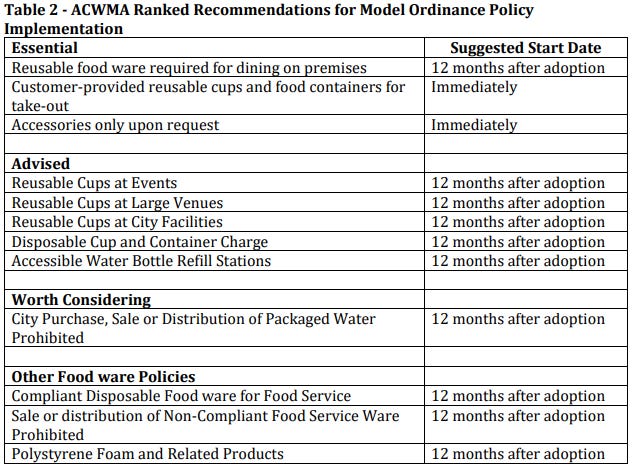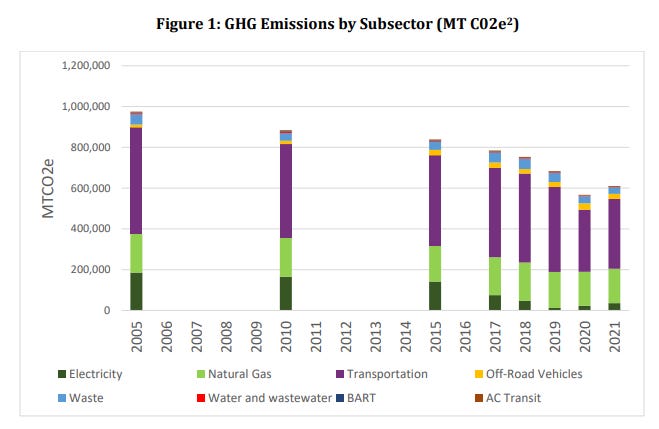Transit and Sustainability Updates For This Week
Designing new transit stops, Hayward Development updates, disposable food containers, and Hayward's Greenhouse Gas Emissions report
AC Transit/Hayward Liaison Committee
This committee is where AC Transit and the City of Hayward work together to make AC Transit work in Hayward. AC Transit has committees with most cities in Alameda County. Ours has Councilmembers Syrop and Zermeno on it. There was no recording of this meeting at the time of writing.
AC Transit Realign
This is mostly just an update on what AC Transit is thinking of doing about the huge changes, both in population and ridership behaviors, that have happened recently. The main takeaways are:
Most bus trips are hyper-local and end within the same city they start.
Fewer people are using the bus for work/commute
The service population is getting smaller and older
Customers generally value more frequent and reliable service over increased coverage (I recall someone making that comment in 2022…)
People want reliable service that’s walkable, comfortable to wait at, and is connected to regional transit like BART.
Right now the plan is getting feedback from people and the relevant agencies (including Hayward City Council), and they’ll have a plan up for adoption in early 2024.
Transit Design Guidelines
Everyone is getting into infrastructure design recently! Apparently they did a big “Multimodal Corridor Guidelines” document back in 2018 and, oopsie-poopsie, “The application of the guidelines resulted in complete streets and traffic calming projects that increased bus travel time, made streets inaccessible to paratransit service, and created risks for passengers.”
That sounds like a pretty complete failure to me. Some writers might say that the idea of “complete streets” is itself, a bit of a failure. I prefer full-separation of automotive traffic, personally, but I know Council loves to take the middle-of-the-road approach which spends the middle amount of money and accomplishes neither of the stated goals particularly well (I’m lookin’ at you Downtown Specific Plan).
Anyway, the new guidelines will take the following into consideration: accommodating paratransit, passenger comfort and safety at bus stops, bus/bike separation, and other design features that promote transit service.
This will, also, get finalized by Spring of 2024, though it doesn’t look like they’ll be doing much community input. So, if you feel passionately, you may want to reach out to your councilmember representatives Syrop and Zermeno.
Hayward Development Updates
Even I can’t keep an eye on everything, like Hayward’s Development Explorer, so thankfully the City is giving AC Transit some development updates so I can save some time.
Residential Projects
966 B Street - (That building that burned down downtown) is going to be a 6 story mixed-use development with 30 market-rate units, still in review, though.
603 A Street - Where that corner market used to be that got torn down. Gonna be 80 more units of senior housing. (Remember when I said Alameda County was getting grayer?)
24646 Mohr Drive - (and the one south of it) 12 units of small-lot single family homes. (These will definitely get us out of the housing crisis, at the cost they’ll be at, I’m certain)
1434 Grove Way - 5 three story townhome units proposed.
Commercial Projects
1060 B Street - AKA That Empty Lot Next To The Masonic Hall, will, eventually, maybe be Arthur Mac’s Big Snack which is supposed to include a repurposed old BART car. Still in review so, who knows how long this’ll take.
Industrial Projects
3700 Enterprise Street - A new water pollution control facility
31161 San Antonio Street - Another huge warehouse
29469 Ruus Road - Another another huge warehouse with an office.
Council Sustainability Committee
This is a subcommittee of the City Council, so it doesn’t have everyone on it. Those who are on it provide feedback on stuff before it goes to the full Council for discussion/votes. Think of it as the first round of policy interviews.
Single-Use Disposable Foodware Ordinance
The Sustainability Committee looked at some language put forward by StopWaste (the Alameda County Waste Management Authority) that Hayward could use to do something about single-use disposable things you eat with. This covers everything from the disposable cup McDonalds gives you to the compostable spoons Panera gives you when you eat in.
The main reason for this is that single use disposable stuff makes up 25% of all waste in California and it makes up the majority of all litter in the Bay Area. So getting rid of it would, in theory, make our City a whole lot cleaner. Which sounds like a good deal to me.
Here’s a table of what StopWaste recommends we do:
I’m 100% all for that. Unfortunately, City Staff recommended a longer timeline than the above because of how restaurants were affected by COVID. And, I have to say, the eco-socialist in me says “So what? The world is literally on fire. Just. Stop.” But the practical part says “I mean… I guess that’s a good idea to not put some restaurants out of business.”
Staff recommended doing an outreach campaign to food businesses this fall and will come back to the Sustainability Committee in early 2024 (a popular time, it seems!) to suggest the best way to go about it.
So I say, if you feel so moved, you should get in contact with some of the local food establishments you frequent and talk to them about it! Because honestly, I’m not sure how much I trust staff to actually… convince anyone of anything. And people don’t like change, so they’re likely to be against it, even if it helps them out in the long-run.
Greenhouse Gas Emissions for the City
Okay, so this one has a LOT of graphs and numbers and stuff. So I’m going to try to hit the highlights without just burying you in graphs and tables.
Hayward has a goal of Carbon Neutrality by 2045. The good news is that we’re ahead of schedule (the next goal is 30% reduction from 2005 levels by 2025). The bad news is that the only reason we’re so far ahead is because of 2020 and we’re backsliding. The majority of the Greenhouse Gas (GHG) Emissions come from “Transportation” which is every vehicle that isn’t public transit or construction vehicles.
Big savings have mostly come from Electricity, since the partnership with East Bay Community Energy has some good renewable packages, which the City keeps trying to promote. Unfortunately, a lot of folks moved to the Bright Choice program, which has gotten dirtier over time, and it’s pushing GHG emissions up because of it. Natural gas went down a bit, but almost nothing by comparison. This should go down soon because new construction needs to be all-electric in City limits.
For vehicle emissions, we went down 30% because of the pandemic, but emissions went up about 12% from 2020 to 2021 and are projected to keep trending upward. This is mostly due to the capitalist push to return to the office and a continued mistrust of public transit. There’s also been a big increase in “off-road vehicles” which includes construction and industrial equipment, because there’s been more construction going on. Where’s my all-electric excavator, Caterpillar?
Anyway, the main takeaway is that personal vehicles are the majority of our emissions with natural gas the next biggest culprit and the return to “normalcy” is just driving vehicle emissions back upward again. Finally, renewable energy has to become cheaper so that we can get everyone onto the fully renewable plan (maybe take state ownership of PG&E while we’re at it, because they’re certainly not gonna do it alone).








